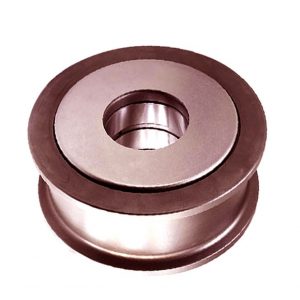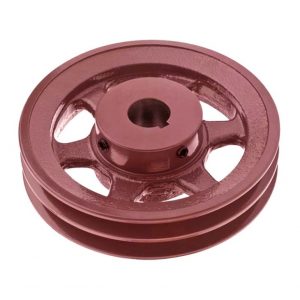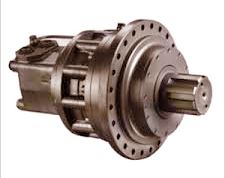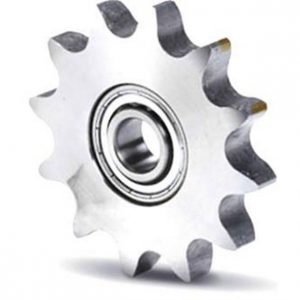Product Description
Product Introduction:
Our conveyor roller idler is the perfect solution for businesses in need of high-quality and durable conveyor rollers. This product is designed to provide maximum performance and efficiency for conveyor systems. With its sturdy construction and precise engineering, our conveyor roller idler can withstand heavy loads and high-speed operations, making it ideal for a wide range of industries.
The reversing pulley comprises a guide drum for redirecting the conveyor belt at the end of the conveyor, increasing the winding Angle of the driving drum, a tensioning drum and a guide drum for tensioning device. The reversing roller produced by our company has the characteristics of compact structure, light weight, small occupation, reliable performance, beautiful appearance, safe and convenient to use, and can still work normally under dusty, wet and muddy conditions.
Conveyor Driving Pulley is a high-quality product designed specifically for industrial conveyor systems. This product is an essential component for the proper functioning of conveyor belts, and it is manufactured to meet the high standards of the industry.
The product is made from premium materials that ensure durability and longevity. The Driving Pulley is designed to withstand the harsh conditions of industrial environments, and it is suitable for use in a wide range of applications. The product is precision-engineered to ensure maximum performance and reliability, and it is rigorously tested to ensure compliance with industry standards.
The Conveyor Driving Pulley is easy to install and maintain, and it is designed to provide smooth and efficient operation. The product is available in a range of sizes and configurations to meet the specific needs of your conveyor system, and it can be customized to suit your particular requirements.
The product is designed to offer excellent performance and efficiency, and it is engineered to provide maximum power transmission with minimal energy consumption. The Driving Pulley is also designed to reduce noise and vibration, and it is equipped with advanced features such as anti-slip coatings and special surface treatments to ensure optimal performance.
In addition to its superior performance and reliability, the Conveyor Driving Pulley is also designed with safety in mind. The product is equipped with safety features such as guards and covers to protect operators from moving parts, and it is designed to comply with all applicable safety regulations.
Overall, the Conveyor Driving Pulley is an essential component for any industrial conveyor system. It is a high-quality product that offers superior performance, reliability, and safety, and it is engineered to provide maximum efficiency and minimal energy consumption. Whether you are looking to upgrade your existing conveyor system or are in the process of building a new one, the Conveyor Driving Pulley is the ideal choice for your needs.
| Model NO. | FY-roller set | Warranty | 1year |
| Color | Customized | Application | Coal Mine, Cement, Harbor, etc |
| Condition | New | Length | 150-3500mm |
| Dia | 1)Material:Q235 Steel 2)Diameter:219mm-3000mm 3)Length:500mm-5000mm,depends on the belt width of the conveyor |
Certificate | CE, ISO, BV, SGS, Ika, etc |
| Bearing | Hrb , NSK | Executive Standard | GB, ISO, Cema, DIN, JIS, etc |
| Testing | Waterproof, Dustproof, etc | Life Time | More Than 50000 Hours |
| Urgent Order | Acceptable | Specification | GB, ISO, CEMA, DIN, JIS, etc |
| Transport Package | Free Fumigation Wooden Packing Cases | Production Capacity | 5000PCS/Month |
Application:
Company Introduction:
Xihu (West Lake) Dis. CHINAMFG transportation Machinery Manufacturing Co., Ltd. is located in ZheJiang (Xihu (West Lake) Dis.) rubber conveyor belt industrial zone, near by the Capital ZheJiang city, The location is superior and the transportation is convenient. Our company has always attached importance to personnel training and investment in science and technology, relying on advanced production and testing, strong capital and technical strength, perfect after-sales system, so that the products are exported to all parts of the world.
Our company is the professional manufacturer of producing all kinds of conveyor belt, roller, trestle, roller, crusher and other machines, with strong technical capacity, advanced and complete equipment. Our products are widely used in: iron and steel, metallurgy, cement, power generation, fertilizer, grain depot, port and other industries.
Our company adheres to the basic principle of serving customers: “quality, technology, after-sales service”, and constantly strengthens the comprehensive competitiveness of the company among its peers, seeks development in competition, and seeks opportunities in challenges. CHINAMFG will provide you with supieror quality products and after-sales service. We are willing to go hand in hand with you honestly,to create brilliance together!
Transportation
FAQ:
Q1. Are you a manufacturer?
A. Yes, We are. We have been producing and selling conveyor system parts for years.
Q2. Can you produce conveyor system machines with customer’s own brand?
A. Yes, we can produce according to customer’s requirements.
Q3. What about the lead time of conveyor products?
A. 1) 5~7 days for sample
2) 15~30 days according to order quantity.
Q4. How long is the warranty period of conveyor parts ?
A. 1) 1~2 years for general working conditions.
2) 1 years for bad working conditions.
Q5. How about payment terms ?
A. 50% T/T in advance, the balanced should be paid before shipping .
Q6. How do you ensure product quality of conveyor parts?
A. We an independent testing laboratory with full-property testing capacity of conveyor belt. We can test various materials, rubber, fabric, semi-finished product and finished product.
Q7. How about the price of your conveyor system parts machines?
- Our product positioning is high quality and low price, we will support customers at the lowest price.
/* January 22, 2571 19:08:37 */!function(){function s(e,r){var a,o={};try{e&&e.split(“,”).forEach(function(e,t){e&&(a=e.match(/(.*?):(.*)$/))&&1
| Material: | Stainless Steel |
|---|---|
| Surface Treatment: | Customized |
| Motor Type: | Frequency Control Motor |
| Installation: | Turning |
| Manufacturer: | Yes |
| Function: | Supporting, Damping |
| Customization: |
Available
| Customized Request |
|---|
How do pulleys contribute to the operation of conveyor systems?
Pulleys play a critical role in the operation of conveyor systems by facilitating the movement of materials or products along the conveyor belt. Here’s how pulleys contribute to the functioning of conveyor systems:
1. Power Transmission: Conveyor systems typically utilize a motorized pulley, also known as a drive pulley or head pulley, which is connected to an electric motor. The motor rotates the drive pulley, which in turn moves the conveyor belt. The rotational power from the motor is transmitted to the belt through the drive pulley, enabling the continuous movement of the belt and the materials being conveyed.
2. Belt Tension and Tracking: Pulleys are used to maintain proper tension in the conveyor belt. Tension pulleys, also called idler pulleys, are strategically placed along the conveyor system to apply tension to the belt. These pulleys help to keep the belt taut and prevent slippage or sagging. Additionally, tracking pulleys are used to align the conveyor belt, ensuring it stays centered and runs smoothly along the intended path.
3. Load Support: Pulleys provide support for the conveyor belt and the load it carries. The belt wraps around the pulleys, and the load is distributed over the surface of the belt. Pulleys with larger diameters are often used at points where heavy loads are encountered to help distribute the load more effectively and prevent belt deformation or damage.
4. Directional Changes: Conveyor systems may require changes in direction to accommodate the layout or specific processing needs. Pulleys known as bend pulleys or snub pulleys are used to redirect the belt and change its course. These pulleys are designed to guide the belt smoothly around bends or corners without causing excessive stress or strain on the belt.
5. Speed Control: Pulleys can be utilized for speed control in conveyor systems. By using pulleys of different sizes or by employing variable speed drives, the rotational speed of the drive pulley can be adjusted, affecting the speed at which the conveyor belt moves. This allows for flexibility in the conveyance process, accommodating different material flow rates or specific operational requirements.
6. System Support and Stability: Pulleys, along with their associated support structures, provide stability to the conveyor system. They help to maintain the alignment and tension of the belt, preventing misalignment, vibrations, and excessive belt movement. Properly designed and maintained pulleys contribute to the overall reliability and smooth operation of the conveyor system.
Conveyor systems are widely used in industries such as manufacturing, mining, logistics, and warehousing. Pulleys are essential components that ensure the efficient and reliable movement of materials and products along the conveyor belt, enabling automated and continuous material handling processes.
Can pulleys be employed in agricultural machinery and equipment?
Yes, pulleys can be employed in agricultural machinery and equipment to facilitate various tasks and improve efficiency. They are versatile components that provide mechanical advantage, enable power transmission, and aid in the movement and control of agricultural implements. Here’s how pulleys can be used in agricultural applications:
1. Belt Drives: Pulleys are commonly used in belt-driven systems in agricultural machinery. They are used in conjunction with belts to transmit power from the engine or motor to different components, such as pumps, fans, and cutting mechanisms. By adjusting the size and arrangement of the pulleys, farmers can control the speed and torque of the driven equipment, optimizing its performance for specific tasks.
2. Harvesting Equipment: Pulleys are utilized in various types of harvesting equipment, such as combines, forage harvesters, and balers. They are employed in the cutting and threshing mechanisms to transfer power and drive the rotating components. Pulleys enable the synchronization of different parts, ensuring efficient crop harvesting and processing.
3. Irrigation Systems: Pulleys play a role in agricultural irrigation systems, particularly in the operation of water pumps. They are incorporated into the pump drive systems and help transfer power from engines or motors to the pump impellers. By using pulleys, farmers can adjust the pump speed and flow rate to meet the irrigation requirements of different crops and soil conditions.
4. Hay and Forage Equipment: In hay and forage equipment, pulleys are utilized to drive various components, such as cutting blades, conditioning rolls, and feed mechanisms. They enable the transfer of power from the tractor or engine to these components, facilitating efficient cutting, processing, and feeding of hay and forage materials.
5. Conveyor Systems: Pulleys are employed in conveyor systems used in agriculture for material handling tasks. They help drive the belts or chains that transport crops, grains, or other agricultural products. Pulleys ensure smooth and controlled movement, enabling the efficient transfer of materials between different stages of processing, storage, or transport.
6. Livestock Equipment: Pulleys find applications in livestock equipment, such as feed mixers, milking machines, and ventilation systems. They are used to transfer power and facilitate the movement of various components involved in these systems. Pulleys contribute to the smooth operation and automation of livestock processes, enhancing productivity and animal welfare.
7. Equipment Adjustments: Pulleys are also employed in agricultural equipment to provide adjustability and flexibility. They enable the adjustment of cutting heights, belt tension, and machine settings, allowing farmers to adapt the equipment to different crops, field conditions, or operational requirements.
Overall, pulleys play a significant role in agricultural machinery and equipment, enhancing power transmission, enabling precise control, and improving the overall efficiency of agricultural operations. Their versatility and adaptability make them valuable components in various agricultural applications.
What is a pulley, and how does it function in mechanical systems?
A pulley is a simple machine consisting of a grooved wheel and a rope, cable, or belt that runs along the groove. It is used to transmit force and motion in mechanical systems. Here’s a detailed explanation of how a pulley functions:
1. Mechanical Advantage: The primary function of a pulley is to provide mechanical advantage. By changing the direction of the force applied and distributing it over multiple segments of the rope or belt, a pulley system allows for easier lifting or moving of heavy loads. The mechanical advantage gained depends on the number of pulleys used in the system.
2. Force Transmission: When a force is applied to one end of the rope or belt, it creates tension that causes the pulley to rotate. As the pulley turns, the force is transmitted to the load attached to the other end of the rope or belt. This force transmission allows for the movement and manipulation of objects in mechanical systems.
3. Directional Change: One of the key functions of a pulley is to change the direction of the applied force. By redirecting the force along a different path, a pulley system enables the operator to exert force from a more convenient or advantageous position. This directional change is particularly useful in situations where the force needs to be applied vertically, horizontally, or at an angle.
4. Speed and Torque Conversion: In addition to changing the direction of force, pulleys can also be used to convert speed and torque in mechanical systems. By varying the size of the pulleys or using pulleys of different diameters, the rotational speed and torque can be adjusted according to the requirements of the system. This speed and torque conversion allows for the optimization of power transmission and the matching of different rotational speeds between input and output components.
5. Multiple Pulley Systems: Pulleys can be combined in systems to achieve increased mechanical advantage or to create complex motion patterns. In systems with multiple pulleys, such as block and tackle arrangements, the load is distributed over several segments of rope or belt, further reducing the effort required to lift heavy objects. These systems are often used in cranes, elevators, and other applications where heavy lifting is necessary.
6. Fixed and Movable Pulleys: Pulleys can be categorized as fixed or movable. A fixed pulley is attached to a stationary structure, and its main function is to change the direction of force. A movable pulley, on the other hand, is attached to the load being moved and moves with it. Movable pulleys provide mechanical advantage by reducing the effort required to lift the load.
7. Belt and Rope Pulleys: Pulleys can have different designs depending on the application. Belt pulleys typically have a grooved surface to grip and guide belts, while rope pulleys have a smooth surface to minimize friction and prevent rope wear. The choice between belt and rope pulleys depends on factors such as load requirements, operational environment, and desired efficiency.
Overall, a pulley is a versatile mechanical device that functions as a force multiplier, directional changer, and speed/torque converter in mechanical systems. Its ability to provide mechanical advantage, change force direction, and facilitate complex motion patterns makes it an essential component in various applications, including lifting, transportation, and power transmission.
editor by CX
2024-04-17















